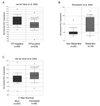Regulation of alphaB-crystallin gene expression by the transcription factor Ets1 in breast cancer
- PMID: 19205872
- PMCID: PMC2791186
- DOI: 10.1007/s10549-009-0330-4
Regulation of alphaB-crystallin gene expression by the transcription factor Ets1 in breast cancer
Abstract
Recent studies indicate that the small heat shock protein alphaB-crystallin is expressed in poor prognosis basal-like breast tumors and likely contributes to their aggressive phenotype. However, the mechanisms underlying the deregulated expression of alphaB-crystallin in basal-like tumors are poorly understood. Using a bioinformatics approach, we identified a putative DNA binding motif in the human alphaB-crystallin promoter for the proto-oncogene Ets1, a member of the ETS transcription factor family that bind to DNA at palindromic ETS-binding sites (EBS). Here we demonstrate that ectopic expression of Ets1 activates the alphaB-crystallin promoter by an EBS-dependent mechanism and increases alphaB-crystallin protein levels, while silencing Ets1 reduces alphaB-crystallin promoter activity and protein levels. Chromatin immunoprecipitation analyses showed that endogenous Ets1 binds to the alphaB-crystallin promoter in basal-like breast cancer cells in vivo. Interrogation of publically available gene expression data revealed that Ets1 is expressed in human basal-like breast tumors and is associated with poor survival. Collectively, our results point to a previously unrecognized link between the oncogenic transcription factor Ets1 and alphaB-crystallin in basal-like breast cancer.
Figures





Similar articles
-
Induction of the small heat shock protein alphaB-crystallin by genotoxic stress is mediated by p53 and p73.Breast Cancer Res Treat. 2010 Jul;122(1):159-68. doi: 10.1007/s10549-009-0542-7. Epub 2009 Sep 24. Breast Cancer Res Treat. 2010. PMID: 19777343 Free PMC article.
-
Regulation of the mouse alphaB-crystallin and MKBP/HspB2 promoter activities by shared and gene specific intergenic elements: the importance of context dependency.Int J Dev Biol. 2007;51(8):689-700. doi: 10.1387/ijdb.072302ss. Int J Dev Biol. 2007. PMID: 17939115
-
AlphaB-crystallin is a novel oncoprotein that predicts poor clinical outcome in breast cancer.J Clin Invest. 2006 Jan;116(1):261-70. doi: 10.1172/JCI25888. J Clin Invest. 2006. PMID: 16395408 Free PMC article.
-
Regulation of mouse small heat shock protein αb-crystallin gene by aryl hydrocarbon receptor.PLoS One. 2011 Apr 11;6(4):e17904. doi: 10.1371/journal.pone.0017904. PLoS One. 2011. PMID: 21494593 Free PMC article.
-
AlphaB-crystallin: a novel marker of invasive basal-like and metaplastic breast carcinomas.Ann Diagn Pathol. 2008 Feb;12(1):33-40. doi: 10.1016/j.anndiagpath.2007.02.004. Epub 2007 Oct 24. Ann Diagn Pathol. 2008. PMID: 18164413
Cited by
-
αB-crystallin: Portrait of a malignant chaperone as a cancer therapeutic target.Pharmacol Ther. 2016 Apr;160:1-10. doi: 10.1016/j.pharmthera.2016.01.012. Epub 2016 Jan 25. Pharmacol Ther. 2016. PMID: 26820756 Free PMC article. Review.
-
αB-crystallin enhances radioresistance in basal-like breast cancer cells by suppressing caspase-3 activation.Sci Prog. 2025 Apr-Jun;108(2):368504251343177. doi: 10.1177/00368504251343177. Epub 2025 May 20. Sci Prog. 2025. PMID: 40390653 Free PMC article.
-
Stromal expression of heat-shock protein 27 is associated with worse clinical outcome in patients with colorectal cancer lung metastases.PLoS One. 2015 Mar 20;10(3):e0120724. doi: 10.1371/journal.pone.0120724. eCollection 2015. PLoS One. 2015. PMID: 25793600 Free PMC article.
-
αB-Crystallin is a Novel Oncoprotein Associated with Poor Prognosis in Breast Cancer.J Breast Cancer. 2011 Mar;14(1):14-9. doi: 10.4048/jbc.2011.14.1.14. Epub 2011 Mar 31. J Breast Cancer. 2011. PMID: 21847389 Free PMC article.
-
The possible functions of duplicated ets (GGAA) motifs located near transcription start sites of various human genes.Cell Mol Life Sci. 2011 Jun;68(12):2039-51. doi: 10.1007/s00018-011-0674-x. Epub 2011 Apr 3. Cell Mol Life Sci. 2011. PMID: 21461879 Free PMC article.
References
-
- Clark JI, Muchowski PJ. Small heat-shock proteins and their potential role in human disease. Curr Opin Struct Biol. 2000;10:52–59. - PubMed
-
- Kamradt MC, Chen F, Cryns VL. The small heat shock protein αB-crystallin negatively regulates cytochrome c- and caspase-8-dependent activation of caspase-3 by inhibiting its autoproteolytic maturation. J Biol Chem. 2001;276:16059–16063. - PubMed
-
- Kamradt MC, Lu M, Werner ME, et al. The small heat shock protein αB-crystallin is a novel inhibitor of TRAIL-induced apoptosis that suppresses the activation of caspase-3. J Biol Chem. 2005;280:11059–11066. - PubMed
Publication types
MeSH terms
Substances
Grants and funding
LinkOut - more resources
Full Text Sources
Medical
Miscellaneous

